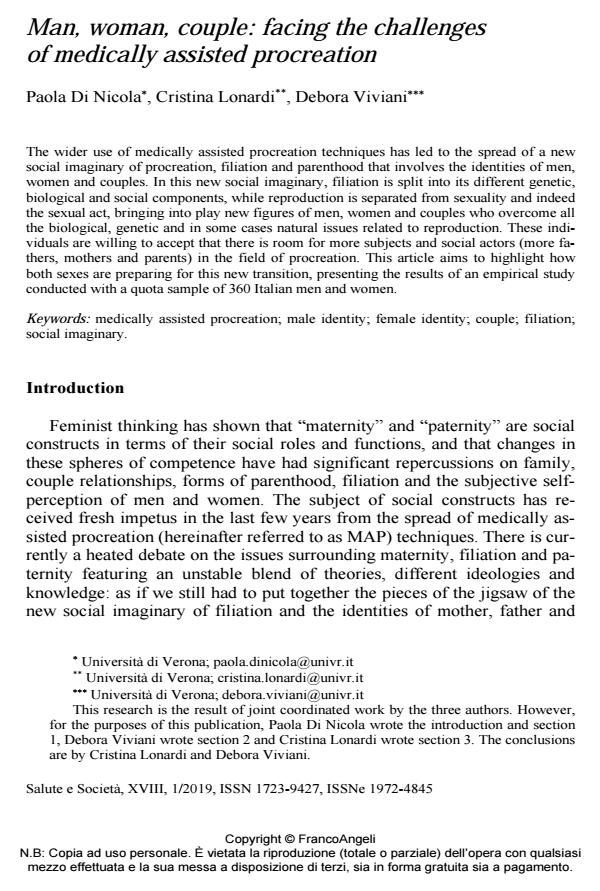Man, woman, couple: facing the challenges of medically assisted procreation
Titolo Rivista SALUTE E SOCIETÀ
Autori/Curatori Paola Di Nicola, Cristina Lonardi, Debora Viviani
Anno di pubblicazione 2019 Fascicolo 2019/1
Lingua Inglese Numero pagine 18 P. 82-99 Dimensione file 249 KB
DOI 10.3280/SES2019-001006
Il DOI è il codice a barre della proprietà intellettuale: per saperne di più
clicca qui
Qui sotto puoi vedere in anteprima la prima pagina di questo articolo.
Se questo articolo ti interessa, lo puoi acquistare (e scaricare in formato pdf) seguendo le facili indicazioni per acquistare il download credit. Acquista Download Credits per scaricare questo Articolo in formato PDF

FrancoAngeli è membro della Publishers International Linking Association, Inc (PILA)associazione indipendente e non profit per facilitare (attraverso i servizi tecnologici implementati da CrossRef.org) l’accesso degli studiosi ai contenuti digitali nelle pubblicazioni professionali e scientifiche
The wider use of medically assisted procreation techniques has led to the spread of a new social imaginary of procreation, filiation and parenthood that involves the identities of men, women and couples. In this new social imaginary, filiation is split into its different genetic, biological and social components, while reproduction is separated from sexuality and indeed the sexual act, bringing into play new figures of men, women and couples who overcome all the biological, genetic and in some cases natural issues related to reproduction. These individuals are willing to accept that there is room for more subjects and social actors (more fathers, mothers and parents) in the field of procreation. This article aims to highlight how both sexes are preparing for this new transition, presenting the results of an empirical study conducted with a quota sample of 360 Italian men and women.
Parole chiave:Medically assisted procreation; male identity; female identity; couple; filiation; social imaginary.
- Andolfi M. (a cura di) (2012). Il padre ritrovato. Milano: FrancoAngeli.
- Anleu S. R. (1992). Surrogacy: for love but not money? Gender & Society, 6: 30-48.
- Bailey A. (2011). Reconceiving Surrogacy: Toward a Reproductive Justice Account of Indian Surrogacy. Hypatia, 4: 715-741.
- Bauman Z. (2003). Liquid Love. On the Frailty of Human Bonds. Oxford: Cambridge. (Italian translation 2008, Amore liquido, Bari-Roma: Laterza).
- Beck U. (1986). Risikogesellschaft. Auf dem Weg in eine andere Moderne. Frankfurt: Suhrkamp (Italian translation 2000, La società del rischio. Verso una seconda modernità, Roma: Carocci).
- Beck U., Beck-Gernsheim E. (1990). Das ganz normale Chaos del Liebe. Frankfurt: Suhrkamp (Italian translation 1996, Il normale caos dell’amore. Torino: Bollati Boringhieri).
- Berend Z. (2012). The Romance of Surrogacy. Sociological Forum, 27(4): 913-936.
- Bertocchi F., Guizzardi L. (a cura di) (2017). We are Family. Same-Sex Families in the Italian Context. Italian Sociological Review, 7(3):
- Deonandan R, Green S, van Beinum A. (2012). Ethical concerns for maternal surrogacy and reproductive tourism. Journal of Medical Ethics, 38: 742 –745.
- Di Nicola P. (2017). Famiglia.: sostantivo plurale. Nuovi orizzonti e vecchi problemi. Milano: FrancoAngeli.
- Galeotti G. (2011). In cerca del padre. Storia dell’identità paterna in età contemporanea. Bari-Roma: Laterza.
- Giddens A. (1992), The Transformation of Intimacy, Cambridge: Polity Press. (Italian translation 1995, La trasformazione dell’intimità: sessualità, amore ed erotisomo nelle società moderne, Bologna: il Mulino).
- Golombok S. (2016). Famiglie moderne. Genitori e figli nelle nuove forme di famiglia, Milano: Edra.
- Iagulli P. (2013), Diritti riproduttivi e fecondazione artificiale. Studio di sociologia dei diritti umani. Milano: FrancoAngeli.
- Marzano M. (2015). Etica oggi. Fecondazione eterologa, «guerra giusta», nuova morale sessuale e altre grandi questioni contemporanee. Trento: Erickson.
- Muraro L. (2016), L’anima del corpo. Contro l’utero in affitto. Milano: Editrice La Scuola.
- Pande A. (2014). Wombs Labour: Transational Commerce Surrogacy in India. Berkeley: Columbia University Press.
- Prasad A. (2014). Storia naturale del concepimento. Come la scienza può cambiare le regole del sesso. Torino: Bollati Boringhieri (Original edition 2012, Like a Virgin: how science is redesigning the rules of sex, UK: Oneworld Publications).
- Ronfani P. (2015). Le responsabilità genitoriale. Il diritto, la cultura giuridica e i saperi esperti. In R. Bosisio, P. Ronfani, a cura di, Le famiglie omogenitoriali. Roma: Carocci.
- Rossi G. (2003). Temi emergenti di sociologia della famiglia. Milano: Vita & Pensiero.
- Rudrappa S. (2015). Discounted Life. The Price of Glogal Surrogacy in India. New York: University Press.
- Rudrappa S. (2017). Reproducing Dystopia: The Politics of Transnational Surrogacy in India 2002-2015. Critical Sociology, 44(7–8): 1087–1101. DOI: 10.1177/089692051774061
- Shalev C. (1998). Nascere per contratto. Milano: Giuffrè Editore (Original edition Birth Power. The case for surrogacy. New Haven and London: Yale University Press).
- Shenfiel F., de Mouzon J., Pennings G., Ferraretti A.P., Nyobe Andersen A., de Wert G., Goosens V. (2010). Cross-border reproductive care in six European countries. Human Reproduction, 25(6): 1361-1368.
- Taylor C. (2005),.Gli immaginari sociali moderni. Roma: Meltemi.
- Teman E. (2003). The medicalization of ‘‘nature’’ in the ‘‘artificial body’’: Surrogate motherhood in Israel. Medical Anthropology Quarterly, 17(1): 78–98.
- Teman E. (2008). The social construction of surrogacy research: An anthropological critique of the psychosocial scholarship on surrogate motherhood. Social Science & Medicine, 67: 1104-1112.
- Teman E. (2010) Birthing a mother: The surrogate body and the pregnant self. Berkeley: University of California Press.
- Viviani D. (2017). It is not mine. Surrogacy: between Natural Body and Artificial Body. Italian Sociological Review, 7(3): 369-38
- Wilkinson S. (2016). Exploitation in International Paid Surrogacy Arrangements. Journal of Applied Philosophy, 33(2): 125-145.
- Zenk F., Loeser E., Schiavo R., Kilpert F., Bogdanovic F., Iovino N. (2017).Germ line–inherited H3K27me3 restricts enhancer function during maternal-to-zygotic transition. Science, 357(6347): 212-21.
Paola Di Nicola, Cristina Lonardi, Debora Viviani, Man, woman, couple: facing the challenges of medically assisted procreation in "SALUTE E SOCIETÀ" 1/2019, pp 82-99, DOI: 10.3280/SES2019-001006